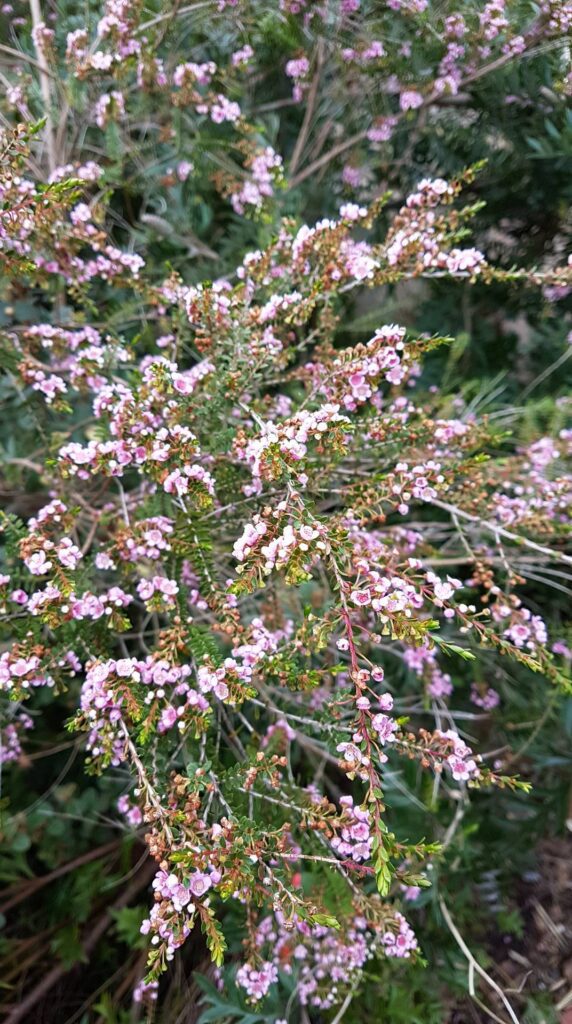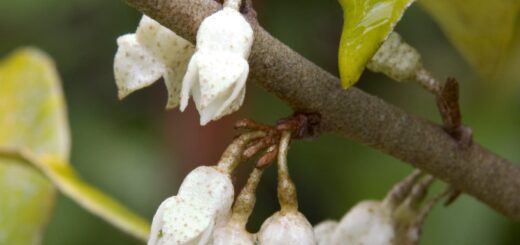Thryptomene Saxicola
Thryptomene saxicola is an Australian native plant from WA. It has small leaves and sprays of tiny pink flowers for most of the year.
Thryptomene is a hero for every sized garden.

Thryptomene is a common plant available at most nursery centres, but has a wide range of benefits
Here at my nursery in Kallista I have had time to observe this plant closely as it is right near the door and front path. This is a bit different for me as I normally have this hard core zone 1 area full of herbs and leafy greens. It is in this spot because the nursery was closed for 2 years and the numerous pots that had been left there put roots down into the ground and grew into full size plants.
This 2m by 2m plot is tightly mixed with 2 thryptomene bushes, 2 very prickly grevillias, 3 types of corea, prickly currant bush, callistemon and plectranthus agenatus. This isn’t how we’ve been told to spread plants out the right distance apart.
But it works. Everything is under 1m high and their width is curtailed by the other plants.
On sunny days in winter (and most of the year) the whole patch is a throng of European bees, native bees, and spectacular native flies, hoverflies and parasitic wasps. It apparently feeds butterflies but I haven’t observed that yet.
It is a fantastic autumn, winter and spring nectar plant for bees and other pollinators. It keeps them coming to the garden for other jobs we’d like them to do. If you keep bees – it’s a great garden food source.
Feeding hoverflies and wasps means that they will be on hand for aphid outbreaks. I always have a base load of aphids in the garden using plants like roses, brassicas gone to seed, evening primrose and anything with sappy new growth. This base load means there are always breeding opportunities for our beneficial insect friends.

A great plant for bees, insects and tiny birds such as the Blue Wren
Having lots of bugs around means you will attract lots of tiny birds to the garden. These insect eating birds keep ecosystems functioning by eating lerp and honeydew as well as bugs in the bark of trees. If you have a high structure in the garden for them to perch on they will buzz the insects we would like a few less of.
Blue Wrens like harlequin bugs. Finches eat bugs up high and down low in my garden. Bill Mollison told me once that most problems in a garden are related to a lack of small birds. They are easy prey for cats, so keep your cats indoors. Have hiding places from the larger birds. Plant pricklies like grevillia, roses, prickly currant bush, rasberries. Let parsley go to seed as an additional bug support. Use dense foliage like lillipilli, and of course Thryptomene. Always have water available in your garden and put some tiny bird houses around the place.
Thryptomene saxicola comes from WA. Dry country in WA. It lives in rocky outcrops but also sand, clayey soils and near salt lakes. I suspect it has a taproot and also fibrous roots making it able to colonise different ecosystems. Again I can’t find specific information on this other than it is extremely hardy once established. I am loathed to investigate the roots of my adult plants but if you wanted to have a look please I’d love to hear your findings.

Thryptomene with some understory action
Plant websites leave out root architecture so often – which makes it hard to design into a forest garden. I suggest we use thryptomene as a forest garden middle story outside the dripline of our fruit, nut, and mast trees. Keep those underplanted with the classics – Comfrey and Yarrow. Thryptomene looks great when amassed, so plant 3 or 4 in a patch of 2m x 2m. It makes a great 1m high hedge too. This will keep the wind off some of your precious food plants.
In a small courtyard it can be grown in a big pot. Place it in a spot that has good sun in winter as well and summer. They like part shade, but the bugs only come when the sun is out.
If you don’t have room for containers, chuck some thryptomene on the verge, roundabout, community garden, or in a local park.
Thryptomene is used for street planting in the Dandenong Ranges. About a third of them have been winter pruned recently, much harder than I tend to prune, back to about 6 larger branches. This will be to stop it getting leggy and promote flowers. I cut it back off the path and take smaller branches for use as cut flowers. They are beautiful to bring inside.
Thryptomene requires good drainage. If you have a boggy site plant them on a mound, raised bed or container. Mulch plants well regardless of location.
Ethnobotany
The leaves smell a bit like the camphorus Vicks. To me this suggests that it could be used in hot water to provide a steam for colds or gunged up airways. It could possibly used as a chest rub too – but beware – these are my thoughts and I haven’t experimented with it yet. I’ve searched for its use like this by Aboriginal people but come up with nothing yet. But the information will be in oral form and probably also early language lists and ethnographies.
I did find that the Anangu women of Uluru use a type of Thryptomene, called Pukara, that grows densely on sand dunes. On winter mornings they beat the bushes with a wooden bowl to collect the morning dew which contained sweet nectar from the flowers.

This means it is a dew harvesting plant as it condenses moisture rising from the ground or falling from mists. It is probably a self watering plant like many Australian natives. To take advantage of its water collecting abilities give the bush a shake to get the droplets to fall to the ground.
Propagation is by cutting, but I’m not great with natives so I get someone else to grow them for me! Use google to find extensive instructions. Thryptomene is a common plant available in most garden centres. In Victoria is the Grampians thryptomene calycina which is also winter flowering and spring flowering. This and other varieties are available at Native Plant nurseries.
So – what a great plant for permaculture design in arid, Mediterranean and temperate climates! Use it widely.
I have a great book called “Grow what where” by Natalie Peate et.al. These uses are from that book. Check it out!
- Rockery plants
- Cottage plants
- Heavy and clay soils
- Sandy soils
- Shady dry conditions
- Second line coastal
- Moderately lime tolerant
- Usually frost tolerant to -4°C
- Spring flowering
- Winter flowering
- Cut flowers
- Pink flowers
- Aromatic foliage
- Container plants
- Cascading plants
- Bird attractant – insect eating birds














